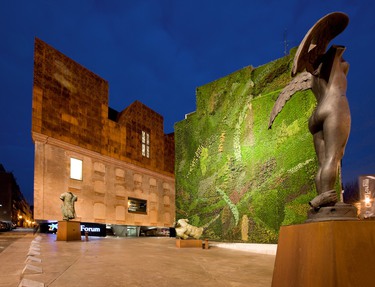
When the good weather arrives it’s a real pleasure to stroll around the city, and if you are in Madrid we would recommend you pay a visit to the CaixaForum, not just to see its exhibitions, but also to admire its vertical garden, created by the botanist Patrick Blanc (currently being looked after by Ferrovial Servicios). This is the first of its kind in Spain, and it weaves a natural tapestry made up 15,000 plants from 250 species, measuring 460 square metres. It is not a mere decorative feature, but an environmental agent, given that it helps to combat pollution, cleaning the air and, at the same time, protecting the wall from bad weather and making it possible to reduce energy consumption (in the winter it insulates from the cold, and in the summer it is a natural cooling system).
There are many advantages to vertical gardens and, as such, if you have a bare wall we would encourage you to create your own vertical garden on one of your home’s surfaces.
Steps to creating your vertical garden
- You can make a vertical garden using both the wall of a balcony or terrace and inside the house. Normally you need the wall to be water-proofed or to fit a protective panel.
- Measure your wall and choose the supports or pots that you are going to use. For instance, you can be original and use plastic guttering, arrange tins on a pallet, or use flower pots. Or even use water-proof felt bags which are the best option if your wall in indoors as you won’t need to protect the wall! Furthermore, they have the advantage of being moveable, taking into account the design of your garden, because some plants grow quicker than others…
- Fit the structure onto the wall from one side to the other. If you use guttering, remember to put stoppers at the end of each piece of tubing so the earth doesn’t fall out.
- To water your garden you can fit a drip irrigation system on the top row, in such a way that the water filters and trickles its way down, thereby watering the plants on the rows below.
- You can go beyond having a vertical garden and set your sights on an entire orchard! So don’t be afraid of planting whatever you like, even vegetables and fruit. You can arrange plants that have shallow roots, in such a way that they can grow well, choosing creeping plants, that is to say ones that will climb across the wall as they grow.
What plants can we hang on the wall?
- Helleborus niger (Christmas rose or Black Hellebore): is one of the plants you can see on the CaixaForum Madrid vertical garden. It flowers from December to March and is used to cold temperatures. The best thing is to plant it on the bottom row so that the rest of the plants provide it with shade in summer and sun in winter.
- Sedum: there are more than 350 accepted species of this genus, plants with fleshy leaves which store water, which makes them ideally suited to dry surroundings.
- Geraniums: this is the most popular plant in the home, with more than 240 species which can be distinguished by the colour of their flowers. It is important that they get light and they are resistant to high temperatures. But they do not respond well to rainwater or irrigation water falling directly on their leaves and flowers, as they rot. Choose whichever one that suits you best depending on where you live.
- Fern: in general this plant likes dampness and there are varieties that are resistant to direct light for hours. They grow downwards, so they will hang over and cover the plants in the rows below them.
- Begonias: you can choose from around 1,500 species of this water-stemmed plant, which flowers the whole year round in a wide range of colours. They generally require warm temperatures and shade, but you can choose whichever one suits you best according to your situation.
- Iris Japónica: this is an iris often used in Patrick Blanc’s designs, and tends to measure 50cm in height. It flowers from April to June, with beautiful petalled flowers ranging from blue to lilac, and even with golden striations.
If you feel inspired and make your own vertical garden, don’t hesitate to share it with us, by sending us your photos.












1 comment
Vista Concepts
14 of March of 2023
Ever felt like making your unused space more attractive? The most significant benefits and advantages of artificial wall gardens are quite versatile, which helps your work environment be relaxed and peaceful. Smart water management that is scientific and well-designed ensures good control over irrigation and construction. You can get more amazing and trending designs for commercial spaces. Reach us. More information is available at https://www.vistaconcepts.com.au/.